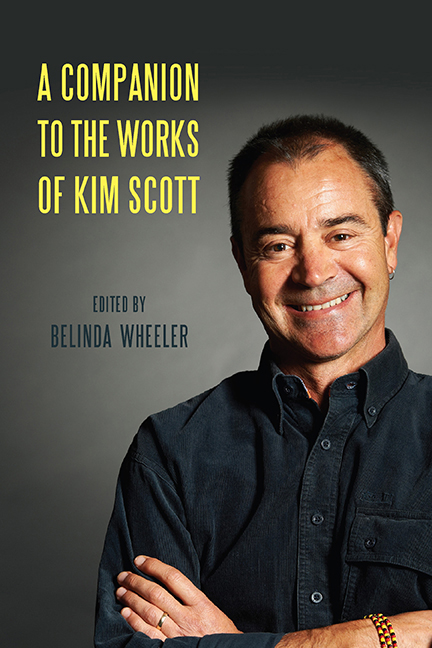Book contents
- Frontmatter
- Contents
- Foreword
- Acknowledgments
- Note on Orthography
- Chronology of Key Writings
- Introduction
- 1 Kim Scott’s Publishing History in Three Contexts: Australian Aboriginal, National, and International
- 2 Kim Scott’s True Country as Aboriginal Bildungsroman
- 3 The Land Holds All Things: Kim Scott’s Benang—A Guide to Postcolonial Spatiality
- 4 Kim Scott’s Kayang and Me: Noongar Identity and Evidence of Connection to Country
- 5 “Wreck/Con/Silly/Nation”: Mimicry, Strategic Essentialism, and the “Friendly Frontier” in Kim Scott’s That Deadman Dance
- 6 The International Reception of Kim Scott’s Works: A Case Study Featuring Benang
- 7 Traumatic Landscapes: Inscribing Spectrality and Identity in Kim Scott’s “A Refreshing Sleep,” “Capture,” and “An Intimate Act”
- 8 Spatial Poetics and the Uses of Ekphrasis in Kim Scott’s “Into the Light” and Other Stories
- 9 The Poetry of Kim Scott
- 10 The Wirlomin Project and Kim Scott: Empowering Regional Narratives in a Globalized World of Literature
- 11 Kim Scott as Boundary Rider: Exploring Possibilities and New Frontiers in Aboriginal Health
- 12 An Interview with Kim Scott
- Notes on the Contributors
- Index
4 - Kim Scott’s Kayang and Me: Noongar Identity and Evidence of Connection to Country
Published online by Cambridge University Press: 08 May 2021
- Frontmatter
- Contents
- Foreword
- Acknowledgments
- Note on Orthography
- Chronology of Key Writings
- Introduction
- 1 Kim Scott’s Publishing History in Three Contexts: Australian Aboriginal, National, and International
- 2 Kim Scott’s True Country as Aboriginal Bildungsroman
- 3 The Land Holds All Things: Kim Scott’s Benang—A Guide to Postcolonial Spatiality
- 4 Kim Scott’s Kayang and Me: Noongar Identity and Evidence of Connection to Country
- 5 “Wreck/Con/Silly/Nation”: Mimicry, Strategic Essentialism, and the “Friendly Frontier” in Kim Scott’s That Deadman Dance
- 6 The International Reception of Kim Scott’s Works: A Case Study Featuring Benang
- 7 Traumatic Landscapes: Inscribing Spectrality and Identity in Kim Scott’s “A Refreshing Sleep,” “Capture,” and “An Intimate Act”
- 8 Spatial Poetics and the Uses of Ekphrasis in Kim Scott’s “Into the Light” and Other Stories
- 9 The Poetry of Kim Scott
- 10 The Wirlomin Project and Kim Scott: Empowering Regional Narratives in a Globalized World of Literature
- 11 Kim Scott as Boundary Rider: Exploring Possibilities and New Frontiers in Aboriginal Health
- 12 An Interview with Kim Scott
- Notes on the Contributors
- Index
Summary
Let no one say the past is dead.
The past is all about us and within.
Haunted by tribal memories, I know
This little now, this accidental present
Is not the all of me, whose long making
Is so much of the past …
A thousand thousand camp fires in the forest
Are in my blood.
Let none tell me the past is wholly gone.
Now is so small a part of time, so small a part
of all the rare years that have moulded me.
—Oodgeroo Noonuccal (Kath Walker), “The Past”FROM KIM SCOTT's EARLIEST EXPLORATION of his own Aboriginal (Noongar) identity in his first novel True Country (1993), set in an imagined place modeled on Kalumburu, a former Benedictine mission in the far north of Western Australia, to his Miles Franklin award-winning novels Benang (1999) and That Deadman Dance (2010), set in the southwest of the state, his works are grounded in contact history and the ways in which the Noongar of southwest Australia have adapted to the incursions of others on to their country or boodjar (earth, sand, ground), the land to which they belong. The embodiment of Aboriginal people's deep connection to country and to their history infuses his oeuvre, as does a certain magical realism that mirrors Aboriginal cultural realities, as Das (2013) suggests in his discussion of Scott's True Country. Each of these works lyrically explores the complexities of intercultural relationships, the impacts of which cannot be restricted to or contained within individuals, families, or even communities. Scott's collaborative life-writing project with Hazel Brown, Kayang and Me (2005), has a special place in his creative output—not only is it a life story but it also offers a key to understanding Scott's journey to his Noongar roots and contact with his extended family and community. With Kayang and Me as its starting point, this chapter explores the value of published life writing—life histories, autobiographies, memoirs, and other self-reflexive writing—and oral histories by Aboriginal people in strengthening identity and language, and the issues involved in their use in relation to native title claims to country.
- Type
- Chapter
- Information
- A Companion to the Works of Kim Scott , pp. 49 - 60Publisher: Boydell & BrewerPrint publication year: 2016



